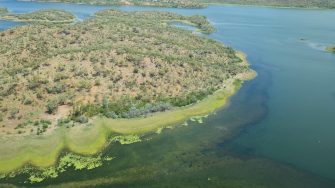
Date: Sunday, November 21, 2021
Project: Eastern Australian Waterbird Survey
Observers: John Porter & Richard Kingsford
Pilot: Tim Dugan
We were one of the first vehicles out to the airport early in the morning, greeted by lots of agile wallabies along the road.
Agile wallaby.
First thing we had to do was wash the plane because it had so much salt from our coastal surveys.
Today we were heading west along survey Band 10. First, we flew across to Proserpine Dam or Peter Faust Dam which regulates flows in Proserpine River. It always has lots of waterbirds.
Surveying Peter Faust Dam.
There were hundreds of black duck, hardhead, coot, black swans, egrets and cormorants. There were also quite a few wood ducks and some grey teal.
From here, it was over the Great Dividing Range to the tributary rivers of the Burdekin River.
Along the way we surveyed the odd the odd farm dam.
Many of them here were only about half full, indicating fairly dry times. One of them even had four jabirus on a very small patch of water; they all looked like immature birds.
Our first river to survey was the Bowen River. It was pretty obvious from the colour of the water, a dirty brown colour, that there had had some recent rainfall. Here there were egrets, large egrets, white-faced herons, and one or two jabirus.
Surveying the Bowen River.
We then flew up the Burdekin River which was flowing quite strongly. We divide up this part of the river into two sections, one below and one above the weir.
Surveying the Burdekin River below the weir.
The weir.
Surveying above the weir.
Dam wall.
And then it was over the dam wall to survey Burdekin Falls Dam. This had dried back in places, exposing areas which had once been flooded but provided green grass for cattle.
Edge of the dam.
We then surveyed farm dams and creeks before reaching Hughenden to refuel.
It was then west to Mt Isa. There were some signs of recent rainfall with some of the rivers with water - a dirty brown colour.
Recent runoff into some of the rivers.
We also surveyed a few small farm dams. There were a few egrets, pelicans, brolgas and grey teal on some of these waterholes in the rivers and dams.
Surveying one of the few farm dams along the way.
Surveying one of the rivers with some water.
We flew past the large Ernest Henry Copper Mine.
And then across the largely dry Cloncurry River, with a few small areas with water. The day got appreciably hotter- the further west we went. Julia Creek, just south of where we surveyed the Cloncurry River recorded 44oC.
Then it was onto the large water supply for Mount Isa Moondarra Dam.
This had reasonably large numbers of glossy Ibis, darters, cormorants, pelicans and some small flocks of wandering whistling-ducks. There were also plenty of swans, egrets and coot. As well as quite a few black duck, a few white pygmy-geese and grey teal. But overall not the really big numbers of waterbirds that we have seen in the past. There were probably less than a thousand birds.
